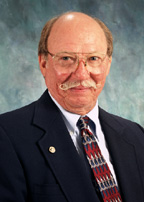 Recruited as a researcher, James Turpen, Ph.D., delivered exactly two lectures to students during his first three years at UNMC.
Recruited as a researcher, James Turpen, Ph.D., delivered exactly two lectures to students during his first three years at UNMC.
Then, Ken Metcalf, M.D., then the chairman of the department of anatomy, invited Dr. Turpen to help teach the embryology core in the College of Medicine. Soon, Dr. Turpen had an appreciation for integrating basic science with clinical practice.
“By giving me the opportunity to teach human embryology, Dr. Metcalf changed my mindset,” Dr. Turpen said. “I really began to appreciate medical students and the importance of their education.”
For his teaching efforts, Dr. Turpen is one of three faculty being honored with the UNMC Outstanding Teaching Award at the Annual Faculty Meeting. It will begin at 4 p.m. Monday, March 31, at the Eppley Science Hall Amphitheater.
Committed to educational mission
“I’m surprised,” said Dr. Turpen, the interim chairman of the department of genetics, cell biology and genetics. “I’m very pleased because I feel a strong commitment to the educational mission of UNMC.”
Born in Wyoming and raised in Colorado, Dr. Turpen came to UNMC in 1983 after serving on the faculty at Tulane University in New Orleans and Penn State University.
Researcher adds teaching to list
“I was looking to come back; I’m a Westerner,” Dr. Turpen said. “I like to look out and see the horizon. In the east, all you can see are trees.”
To UNMC, Dr. Turpen brought with him an active research program, studying hematopoiesis, the formation and development of blood cells in bone marrow. He hadn’t taught lectures since serving as a teaching assistant during his graduate education at the University of Denver and Tulane.
By the early 1990s, however, Dr. Metcalf was ready to retire and Dr. Turpen was ready to take over the embryology core. He says that in the classroom, progress and results are more immediate and more obvious than those that researchers see.
“With the students you can say that you make a difference in a person’s life and career,” Dr. Turpen said. “Teaching gives you the opportunity to have an impact on students. Part of what we do is give them knowledge, expand their base.”
Enhancing learning
Gordon Todd, Ph.D., associate professor in genetics, cell biology and anatomy, noted that teaching is “not just standing up in front of the students and giving a lecture.”
“It is interacting with the students to promote and enhance learning,” Dr. Todd wrote. “I have worked with Jim for a number of years in the histology course for medical students. I have seen first hand how he presents information in an informative and practical approach, but more importantly, how he interacts with the students to draw them out rather than just giving them the answer.”
Active participation
Todd Lovgren, a second-year medical student, agreed with Dr. Todd’s assessment of Dr. Turpen.
“Dr. Turpen also placed responsibility on students to listen and learn during lecture rather than sit idly by,” Lovgren said. “By drawing me into his lectures, I actively participated and learned the material.”
Colorful teaching style
Dr. Turpen’s students often comment on his colorful approach – literally. Dr. Turpen uses different colors in his embryology lectures to represent different layers of tissue, using the same color for a specific tissue throughout the course. He recommends that students bring six or seven different color markers to help follow some of the changes the embryo undergoes during development.
“Initially, everyone thinks it’s a silly waste of time,” Lovgren said. “Then you have to study your notes and you realize how important the ‘recommendation’ was. Without his direction, it would all appear as a knot of black lines.”
Said Katherine Venable, a first-year medical student: “This practice is an excellent idea for teaching embryology and even now, I still remember that endoderm is green, mesoderm is red and ectoderm is blue.”
Dr. Turpen said that he tries to challenge students, and he expects them to be prepared for class lectures. He’s also willing to sit down with individual students at any time to work through any difficulties.
Round of applause
He said a highlight came during the fall of 2001. During the last lecture in embryology, Dr. Turpen pointed out how some of the major events of development can be influenced by environmental conditions.
“When I was done, the students applauded,” Dr. Turpen said. “That really got to me. We don’t normally receive applause for our lectures in the class.”
Ethical dilemmas
Dr. Turpen says he also tries to introduce students to some of the ethical dilemmas that they’ll face as physicians.
“As health professionals, they need to make their decisions based on factual information,” he said. “I try to point out ethical dilemmas, leave it up to them to decide what the outcome should be.”
Juggling tasks
The students, he said, are most commonly tough, but fair.
“They’re a tough crowd,” Dr. Turpen said. “They have high expectations. They expect a lot from the faculty, and it’s good that they expect that.”
In addition to his classroom work and his chairmanship of the department, Dr. Turpen also is the principal investigator for a three-year, $6 million grant that seeks to engage undergraduate students across the state in research activities.
Beyond UNMC
Dr. Turpen and his wife, Paula, have five children. A third-generation Shriner, Dr. Turpen also is an amateur clown and a Scoutmaster with the Boys Scouts of America. The family enjoys getting away on their boat on the Missouri River, and he and his youngest son, Ross, took up golf last summer.